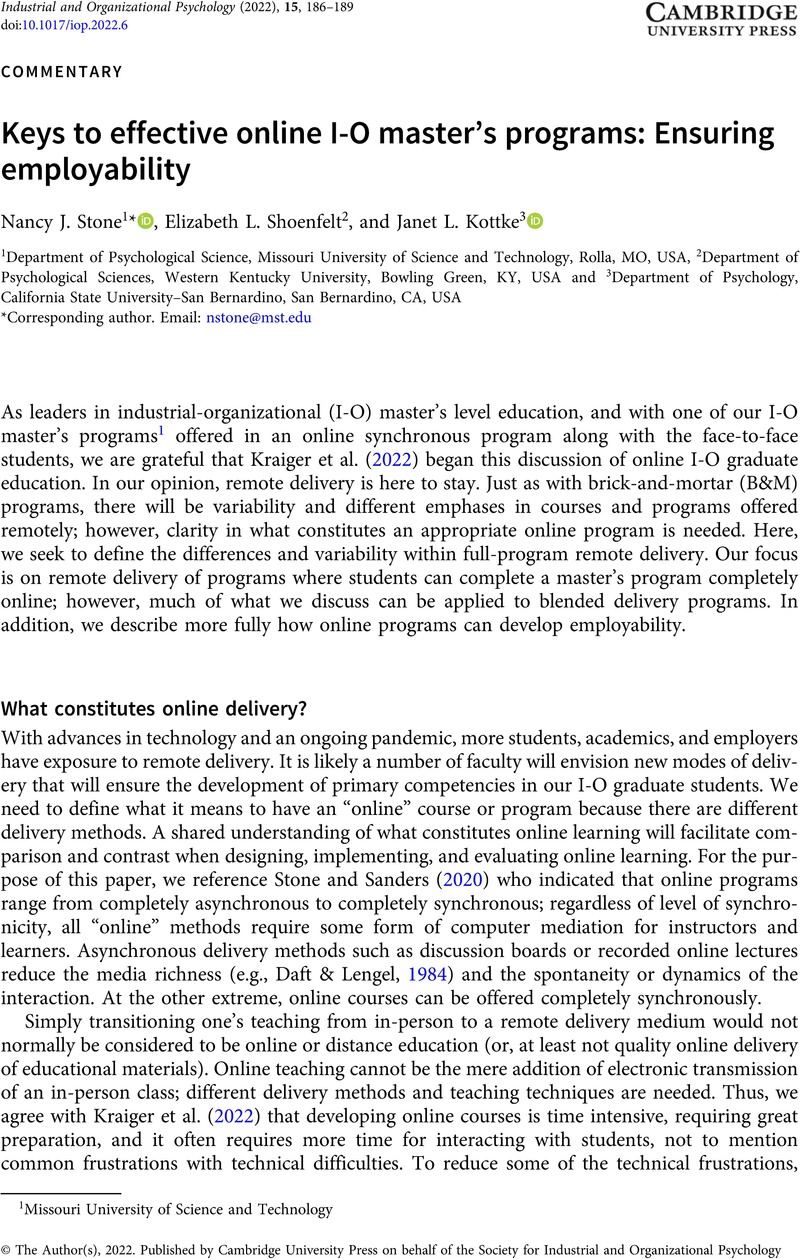No CrossRef data available.
Article contents
Keys to effective online I-O master’s programs: Ensuring employability
Published online by Cambridge University Press: 26 May 2022
Abstract
An abstract is not available for this content so a preview has been provided. Please use the Get access link above for information on how to access this content.

- Type
- Commentaries
- Information
- Copyright
- © The Author(s), 2022. Published by Cambridge University Press on behalf of the Society for Industrial and Organizational Psychology
References
Daft, R. L., & Lengel, R. H. (1984). Information richness: A new approach to managerial behavior and organization design. Research in Organizational Behavior, 6, 191–233.Google Scholar
Hogan, R., Chamorro-Premuzic, T., & Kaiser, R. B. (2013). Employability and career success: Bridging the gap between theory and reality. Industrial and Organizational Psychology: Perspectives on Science and Practice, 6, 3–16.CrossRefGoogle Scholar
Kraiger, K., Fisher, S., Grossman, R., Mills, M. J., & Stizmann, T. (2022). Online I-O graduate education: Where are we and where should we go? Industrial and Organizational Psychology: Perspectives on Science and Practice, 15(2), 151–171.Google Scholar
Manwaring, K. C., Larsen, R., Graham, C. R., Henrie, C. R., & Halverson, L. R. (2017). Investigating student engagement in blended learning settings using experience sampling and structural equation modeling. Internet and Higher Education, 35(October), 3521–3533. doi: 10.1016/j.iheduc.2017.06.002
CrossRefGoogle Scholar
Shockley, K. M., Gabriel, A. S., Robertson, D., Rosen, C. C., Chawla, N., Ganster, M. L., & Ezerins, M. E. (2021). The fatiguing effects of camera use in virtual meetings: A within-person field experiment. Journal of Applied Psychology, 106(8), 1137–1155. http://dx.doi.org/10.1037/apl0000948
CrossRefGoogle ScholarPubMed
Shoenfelt, E. L., Stone, N. J., & Kottke, J. L. (2013). Internships: An established mechanism for increasing employability. Industrial and Organizational Psychology: Perspectives on Science and Practice, 6(1), 24–27. doi: 10.1111/iops.12004
CrossRefGoogle Scholar
Society for Industrial and Organizational Psychology, Inc. (2016). Guidelines for education and training in industrial-organizational psychology. https://www.siop.org/Events-Education/Graduate-Training-Program/Guidelines-for-Education-and-Training
Google Scholar
Stone, N. J. (2021). Understanding learning environments, personality, and proctoring during mandatory remote delivery. Proceedings of the Human Factors and Ergonomics Society 65th Annual Meeting, 65(1), 767–770.CrossRefGoogle Scholar
Stone, N. J., & Sanders, A. M. F. (2020). Applying to I-O master’s programs: Program selection, undergraduate preparation, and application process. In Shoenfelt, E. L. (Ed.), Mastering industrial-organizational psychology: Training issues for master’s level I-O psychologists (pp. 17–37). Oxford University Press.CrossRefGoogle Scholar
Zelin, A., Lider, M., & Doverspike, D. (2015, December). SIOP career study executive report. Center for Organizational Research, The University of Akron. https://www.siop.org/Portals/84/PDFs/Professionals/SIOP_Careers_Study_Executive_Report_FINAL-Revised_031116.pdf?ver=2019-06-26-075622-550
Google Scholar




